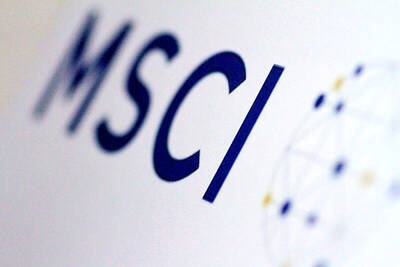Chip sales are set to cool more than previously expected as the global economy struggles under the weight of rapid interest rate increases and rising geopolitical risks, fueling fears of a recession.
World Semiconductor Trade Statistics (WSTS), a non-profit body that tracks shipments, lowered its market outlook to 13.9 percent growth this year from 16.3 percent. For next year, it sees chip sales rising just 4.6 percent, the weakest pace since 2019.
The market is still expected to surpass US$600 billion this year, WSTS forecast. Next year’s forecast growth would be the weakest since a 12 percent drop in sales at the height of the US-China trade dispute.

Photo: Reuters
Chip sales are an important indicator of global economic activity as households and firms increasingly rely on digital devices and online services to consume and expand.
US President Joe Biden this month signed the so-called CHIPS and Science Act aimed at strengthening the US semiconductor industry as China races to expand its own chipmaking capacity.
Japan is likely to see the strongest sales growth at 5 percent next year, followed by the Americas at 4.8 percent and the Asia-Pacific region at 4.7 percent, WSTS said. Europe, where Russia’s invasion of Ukraine is reverberating across the continent’s economy, is likely to post an expansion of just 3.2 percent.
Based in Morgan Hill, California, WSTS includes among its members Texas Instruments Inc, Samsung Electronics Co, Sony Semiconductor Solutions Corp and Yangzhou Yangjie Electronic Technology Co (揚州揚傑電子科技), according to its Web site.
Separately, US-based market information advisory firm IC Insights yesterday said it has adjusted its global semiconductor capital expenditure forecast this year to grow 21 percent year-on-year to US$185.5 billion, compared with the previous estimate of a 24 percent increase to US$190.4 billion it made at the beginning of the year.
The downward adjustment came as the semiconductor industry faces soaring inflation and a rapidly decelerating worldwide economy, causing many semiconductor manufacturers to re-evaluate their aggressive expansion plans, IC Insights said in a press release.
“Several (but not all) suppliers — particularly many leading DRAM and flash memory manufacturers — have already announced reductions in their capex [capital expenditure] budgets for this year,” it said. “Many more suppliers have noted that capital spending cuts are expected in 2023 as the industry digests three years of robust spending and evaluates capacity needs in the face of slowing economic growth.”
Despite the downward adjustment, the revised capital expenditure forecast for this year still represents a new record high and would mark the first three-year period of double-digit gains in the semiconductor industry since 1993 to 1995, IC Insights said.
Additional reporting by Chen Cheng-hui

PERSISTENT RUMORS: Nvidia’s CEO said the firm is not in talks to sell AI chips to China, but he would welcome a change in US policy barring the activity Nvidia Corp CEO Jensen Huang (黃仁勳) said his company is not in discussions to sell its Blackwell artificial intelligence (AI) chips to Chinese firms, waving off speculation it is trying to engineer a return to the world’s largest semiconductor market. Huang, who arrived in Taiwan yesterday ahead of meetings with longtime partner Taiwan Semiconductor Manufacturing Co (TSMC, 台積電), took the opportunity to clarify recent comments about the US-China AI race. The Nvidia head caused a stir in an interview this week with the Financial Times, in which he was quoted as saying “China will win” the AI race. Huang yesterday said

Nissan Motor Co has agreed to sell its global headquarters in Yokohama for ¥97 billion (US$630 million) to a group sponsored by Taiwanese autoparts maker Minth Group (敏實集團), as the struggling automaker seeks to shore up its financial position. The acquisition is led by a special purchase company managed by KJR Management Ltd, a Japanese real-estate unit of private equity giant KKR & Co, people familiar with the matter said. KJR said it would act as asset manager together with Mizuho Real Estate Management Co. Nissan is undergoing a broad cost-cutting campaign by eliminating jobs and shuttering plants as it grapples

The Chinese government has issued guidance requiring new data center projects that have received any state funds to only use domestically made artificial intelligence (AI) chips, two sources familiar with the matter told Reuters. In recent weeks, Chinese regulatory authorities have ordered such data centers that are less than 30 percent complete to remove all installed foreign chips, or cancel plans to purchase them, while projects in a more advanced stage would be decided on a case-by-case basis, the sources said. The move could represent one of China’s most aggressive steps yet to eliminate foreign technology from its critical infrastructure amid a

MORE WEIGHT: The national weighting was raised in one index while holding steady in two others, while several companies rose or fell in prominence MSCI Inc, a global index provider, has raised Taiwan’s weighting in one of its major indices and left the country’s weighting unchanged in two other indices after a regular index review. In a statement released on Thursday, MSCI said it has upgraded Taiwan’s weighting in the MSCI All-Country World Index by 0.02 percentage points to 2.25 percent, while maintaining the weighting in the MSCI Emerging Markets Index, the most closely watched by foreign institutional investors, at 20.46 percent. Additionally, the index provider has left Taiwan’s weighting in the MSCI All-Country Asia ex-Japan Index unchanged at 23.15 percent. The latest index adjustments are to